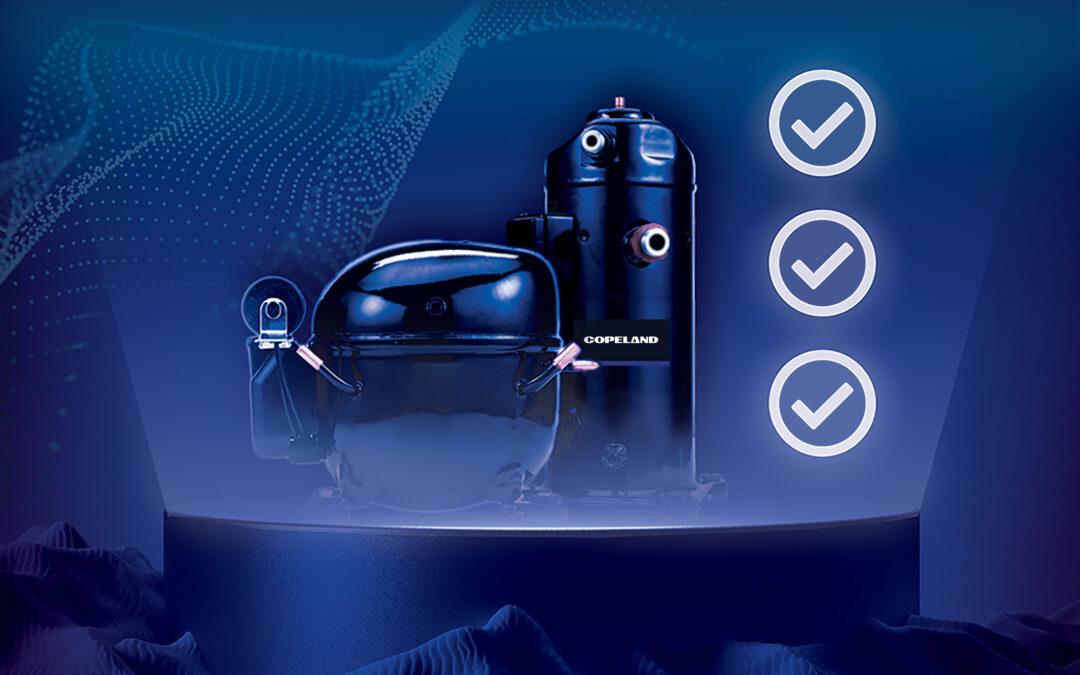*On June 1, 2023 Emerson’s Climate Technologies business became a new standalone company – Copeland. Though our name has changed, we are building on more than a century of HVACR innovation and industry leadership, and Copeland continues to offer the same products, industry stewardship, and learning opportunities you’ve grown to trust. Information found on this webpage posted before June 1, 2023 may contain our old name or branding, but you can be at ease knowing it was created with the knowledge and expertise of Copeland.
As the transition from hydrofluorocarbon (HFC) refrigerants with high global warming potential (GWP) continues in the U.S., commercial refrigeration stakeholders are actively pursuing emerging low-GWP alternatives. Among these include a variety of synthetic and natural options, from A1s with a familiar footprint to mildly flammable A2Ls to the naturals A3 (R-290) and CO2 — all of which can meet very-low GWP thresholds but have varying characteristics which dictate system design architectures. In our most recent E360 Webinar, a leading European retailer provided details about how they chose an A2L refrigerant as the basis for their organization’s refrigerant transition.

Although A2L safety standards have yet to be finalized in the U.S., the case study presented by Brian Churchyard, senior manager of engineering and energy of UK-based ASDA stores, provided a useful framework for how U.S. retailers could follow a similar path to regulatory compliance and sustainable refrigeration. He detailed ASDA’s journey toward lower-GWP refrigeration, which ultimately concluded in the selection of A2L refrigerant R-454A with a GWP of 238.
Creating a new refrigeration design standard
Churchyard explained how ASDA formed a collective working group comprised of numerous agencies, private businesses and industry experts to conduct a detailed assessment of A2Ls. The group developed a design standard for the safe application of their chosen refrigerant, which was based on existing data from the use of R-290 (even though A2L flammability levels were well below those of R-290).
After comparing the performance of A2L refrigerants to other alternatives through numerous trials, the ASDA team concluded that their new design standard achieved their objectives of lowering capital investment, energy consumption, lifecycle costs and carbon emissions. It’s important to note that while R-454A does not have the lowest GWP of the available A2L alternatives, it offered performance improvements that helped to meet these sustainability goals while adhering to the EU’s F-Gas regulatory requirements.
Moving to an A2L also required a reduction in refrigerant charge, which dictated that ASDA would also need to transition from large, centralized rack systems to smaller distributed remote systems. Churchyard said that other benefits of a decentralized approach included limiting the potential for leaks while eliminating risk by having a single point of failure.
Focus on safety and leak mitigation
Of course, safety is a primary concern when using a flammable or mildly flammable refrigerant, and minimizing leaks was an essential part of ASDA’s design strategy. Churchyard stressed that leak prevention was a top priority in all their refrigeration system trials — whether it was an A1 HFC, CO2, hydrofluoroolefin (HFO) or A3 refrigerant. Preventing leaks not only minimizes the potential for emissions, but also ensures that the system is operating at full capacity and efficiency.
Churchyard said that in the event of a leak, display cases are equipped with a modular alarm system integrated into the case controller. If leakage is detected within a case, the system will activate an alarm that effectively triggers a shut-off valve that stops refrigerant flow to a particular display case. In addition, leakage thresholds are set at such a low level as to prevent the potential for A2L ignition. Quality inherent among system joints, connections and proper installation was a major collective focus of the new design standard, which included remote distributed refrigeration plants and their associated display cases.
Churchyard said case upgrades were often the first part of their refrigerant transition strategy. When store operators identified existing HFC cases that needed to be replaced, the first step was to upgrade to cases that were compatible for A2L use — even though they were still using an A1. Then, when the distributed A2L refrigeration plants were installed, these stores could safely transition over to the use of the R-454A A2L refrigerant.
ASDA has been leveraging this strategy since 2019, when it was recognized as the first retailer to adopt an all-A2L refrigerant strategy. To learn more details about ASDA’s successful refrigerant transition, please view this webinar.

Electrical component considerations for A2L system safety
Electrical component considerations for A2L system safety As a new refrigerant category in the...

A2L refrigerant regulation updates: what you need to know today
Preparing for the approval and safe use of A2Ls in commercial refrigeration applications The move...

Address Efficiency Mandates with Compression Technologies
Strategies for complying with DOE and ENERGY STAR® in self-contained and remote condensing units...
